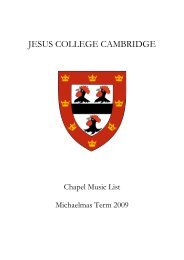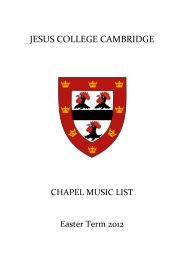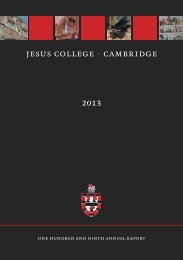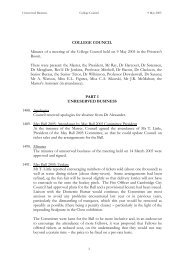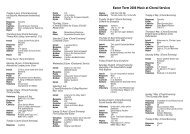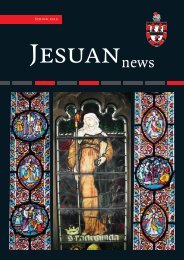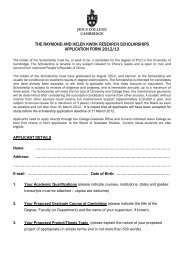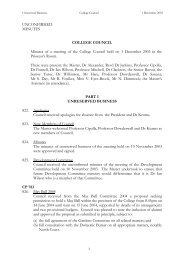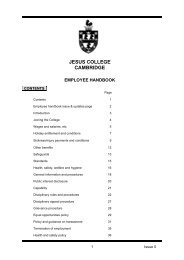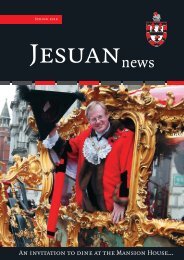2012 Annual Report - Jesus College - University of Cambridge
2012 Annual Report - Jesus College - University of Cambridge
2012 Annual Report - Jesus College - University of Cambridge
Create successful ePaper yourself
Turn your PDF publications into a flip-book with our unique Google optimized e-Paper software.
54 CREATOR OF THE MODERN COLLEGE I <strong>Jesus</strong> <strong>College</strong> <strong>Annual</strong> <strong>Report</strong> <strong>2012</strong><br />
Black Morgan: Vanity Fair, 1889<br />
value for its money. 11 It was he too, as Dean,<br />
who had work on the Chapel’s restoration<br />
resumed, appealing for funds and seeing the<br />
outer Chapel transformed with William<br />
Morris’s richly painted nave ceiling, and its<br />
windows filled with as fine a collection <strong>of</strong><br />
stained glass – by Morris, William Burne-<br />
Jones and Ford Madox Brown – as can be<br />
found in any church <strong>of</strong> comparable size. For<br />
thirty years – until ‘Red’ Morgan’s death in<br />
1895 – the two Morgans were to be the closest<br />
<strong>of</strong> collaborators. They not only ran, they<br />
dominated, the <strong>College</strong> : they were it, and it<br />
was them. And when ‘Black’ Morgan was<br />
elected Master, it was ‘Red’ Morgan who<br />
succeeded him as Senior Tutor (three were<br />
now needed) while continuing as Dean.<br />
Their partnership’s fame spread well beyond<br />
<strong>Cambridge</strong>: in 1889 Vanity Fair published<br />
‘Spy’ cartoons <strong>of</strong> both <strong>of</strong> them.<br />
Sensing the Victorian middle class’s<br />
growing appetite for university education – to<br />
fill the gap between a young man’s leaving<br />
school and being fit for an appropriate job or<br />
pr<strong>of</strong>ession – and with the B.A. (though not<br />
the M.A.) degree now open to non-Anglicans,<br />
Morgan’s aim was not just to return student<br />
numbers to 1849-53 levels, but significantly<br />
to increase them. A Tutor’s repute and<br />
prestige – and his income – depended on<br />
how many students he had in his college.<br />
There was no <strong>University</strong> or (except at Trinity)<br />
college entrance examination and no<br />
educational requirement for matriculation:<br />
Morgan was to oppose their introduction. 12<br />
But if <strong>Jesus</strong> was to have more students, more<br />
rooms would be needed. In 1863 it was a<br />
college <strong>of</strong> two-and-a-bit courts – the<br />
attractive Entrance Court dominated by the<br />
Gate Tower, the rather damp and pokey<br />
Cloister Court, and a Pump Court which<br />
extended only to K staircase, and embraced<br />
the <strong>College</strong> Cook’s vegetable garden.<br />
At the December 1867 Audit meeting, it<br />
was agreed “that power be given to the<br />
resident Society to consider the expediency <strong>of</strong><br />
enlarging the present <strong>College</strong> buildings and<br />
to report thereon to the Society at large”, and<br />
fourteen months later, on 2 February 1869,<br />
the Fellows agreed to Morgan’s proposal –<br />
written into the Conclusions Book in his own<br />
hand – that<br />
“In consideration <strong>of</strong> the greatly<br />
increased number <strong>of</strong> undergraduates<br />
admitted <strong>of</strong> this <strong>College</strong> and <strong>of</strong> the<br />
increased number <strong>of</strong> young persons<br />
generally throughout the country for<br />
whom education at the universities has<br />
become an object <strong>of</strong> interest and<br />
importance . . . the Master and Fellows<br />
have felt to be necessary to consider<br />
whether or not it be their duty to build a<br />
certain number <strong>of</strong> additional sets <strong>of</strong><br />
rooms within the <strong>College</strong> precincts for<br />
the accommodation <strong>of</strong> those students<br />
who are now compelled to occupy<br />
lodgings in the town”<br />
to approve Waterhouse’s plans for 22 (later<br />
increased to 24) sets “and to give the resident<br />
Society authority to raise the necessary funds<br />
to carry out the Designs.” Taking advantage<br />
<strong>of</strong> recent legislation which had, for the first<br />
time, permitted colleges to borrow, most <strong>of</strong><br />
those necessary funds – the builder’s tender<br />
was for £6248 – were found in the Rustat<br />
Trust’s reserves, and were to be repaid over<br />
thirty years. 13<br />
Morgan’s vigorous student-recruitment<br />
campaign had already borne fruit. By 1868



